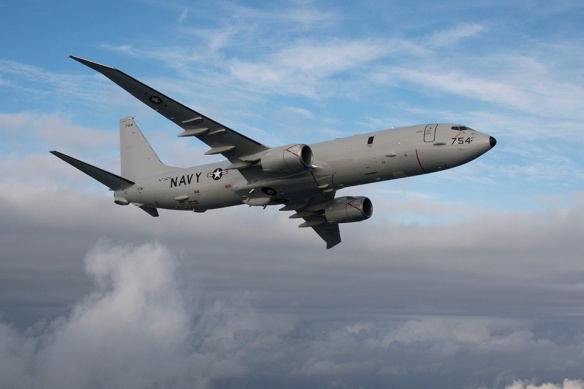The U.S. Navy’s newest maritime patrol and reconnaissance test aircraft, P-8A Poseidon flies with a P-3C Orion alongside, prior to landing at Naval Air Station Patuxent River, Md., on April 10. The P-8A began its formal flight test program at the Boeing Seattle facilities in October 2009. The Poseidon integrated test team expects to receive two more test aircraft at NAS Pax River later this year.
Mission
The P-8A Poseidon is being designed to replace the P-3C Orion as a long-range anti-submarine warfare (ASW), anti-surface warfare (ASuW), intelligence, surveillance and reconnaissance (ISR) aircraft capable of broad-area, maritime and littoral operations.
Description
The P-8A Poseidon is designed to secure the Navy’s future in long-range maritime patrol capability, while transforming how the Navy’s maritime patrol and reconnaissance force will man, train, operate and deploy. The P-8A will provide more combat capability from a smaller force and less infrastructure while focusing on worldwide responsiveness and interoperability with traditional manned forces and evolving unmanned sensors.
P-8A Poseidon will leverage the experience and technology of the P-3C’s capabilities and assets to meet the Navy’s needs of developing and fielding a maritime aircraft equipped with significant growth potential, including an extended global reach, greater payload capacity, higher operating altitude, and the open systems architecture.
Operational history
In February 2012, the P-8 made its mission debut during “Bold Alligator” 2012, an annual littoral warfare exercise. In April 2012, the aircraft took part in Exercise Joint Warrior, flying out of RAF Lossiemouth. During RIMPAC 2012 in the Hawaiian area, two P-8As participated in 24 exercise scenarios as part of Air Test and Evaluation Squadron One (VX-1) while forward deployed to Marine Corps Base Hawaii (former MCAS Kaneohe Bay). U.S. Navy P-8s may rotate through bases of American allies such as “…the Philippines or Thailand to help those nations with maritime domain awareness.”
On 29 November 2013, the P-8’s inaugural deployment began when squadron VP-16 departed its home station of NAS Jacksonville, Florida, for Kadena Air Base in Okinawa, Japan and forward deployment with the U.S. Pacific Fleet. Six aircraft and 12 air crews were deployed to supplement Regular Navy and Navy Reserve P-3Cs already deployed to/based out of Kadena AB. The deployment was pre-planned as an enhancement of ISR and anti-submarine capabilities for the Pacific re-balance, but occurred shortly after the Chinese announcement of the East China Sea Air Defense Identification Zone, which heightened tensions in the region.
During exercises in 2012-2013 and an overseas deployment to Japan, the aircraft reportedly exhibited radar, sensor integration, and data transfer problems; leading to additional testing being performed. In January 2014, the Pentagon’s Director of Operational Test and Evaluation office called the P-8A ‘ineffective’ for large area ISR and anti-submarine warfare missions, and said that the initial aircraft were not ready for deployment. The same report found that the P-8 was effective at the small-area search mission, and with much better range, speed, and reliability than older aircraft. Pentagon acquisition undersecretary Frank Kendall has disputed the report, saying that although its findings are factual, it did not acknowledge future capability upgrades for anti-submarine and wider-area surveillance.
A second squadron, VP-5, completed its transition to the P-8 in August 2013 with its next overseas deployment slated for mid-2014. A third squadron, VP-45, began its transition to the Poseidon in July 2013.
On 13 March 2014, a U.S. Navy P-8A participated in the search for the missing Malaysia Airlines Flight 370, flying from Kuala Lumpur, Malaysia. On 27 March 2014, a second U.S. Navy P-8A, stationed in Okinawa, Japan deployed to Perth, Australia to participate in the search.
Specifications
Primary Function: Anti-Submarine Warfare (ASW) and Anti-surface Warfare (ASuW), Intelligence, Surveillance and Reconnaissance (ISR)
Contractor: Boeing Integrated Defense Systems (IDS)
Propulsion: 2 CFM 56-7B engines with 27,300 lbs thrust each
Length: 129.5 feet (39.47 meters)
Height: 42.1 feet (12.83 meters)
Wingspan: 123.6 feet (37.64 meters)
Maximum Gross Takeoff: 189,200 pounds (85,820 kilograms)
Airspeed: 490 knots (564 mph) true air speed
Ceiling: 41,000 feet (12,496 meters)
Range: 1,200 nautical miles radius with four hours on station
Crew: Nine
Armament: Torpedoes, cruise missiles, bombs, mines
